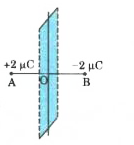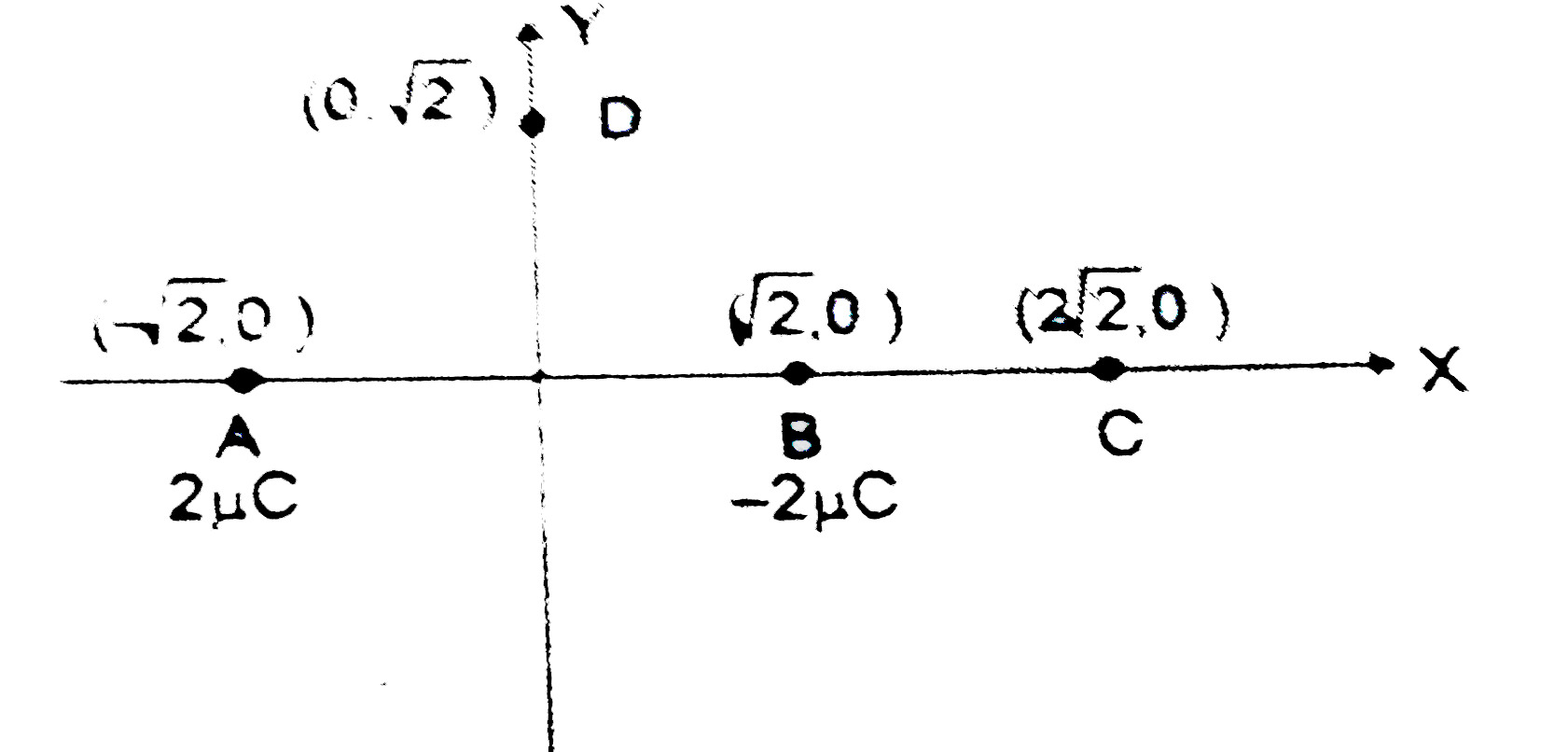Two charges 2μCand−2μC are placed at points A and B 6 cm apart.
(a) Identify an equipotenital surface of the system.
(b) What is the direction of the electric field at every point on this surface ?
(a) As both the charges from an electric dipole of length 6 cm, the equatorial plane for this electric dipole, i.e plane perpendicular to line AB and passing through the midpoint of line AB, is an equipotential surface for the given system.

Electric potential of this equipotential surface is zero because both charges are equidistant. The above described equipotential surface is planar. Other equipotential surfaces are curved.
(b) Electric field at the equatorial plane is perpendicular to the plane and is in the direction opposite to that of the electric dipole moment. Thus, the direction of the electric field will be normal to the equipotential surface along AB, i.e. from +2μC to −2μC.
Topper's Solved these Questions
- BOOK - MODERN PUBLICATIONCHAPTER - ELECTROSTATIC POTENTIAL AND CAPACITANCE EXERCISE - NCERT FILE Solved (Additional Exercises)23videos
ELECTROSTATIC POTENTIAL AND CAPACITANCE
- BOOK - MODERN PUBLICATIONCHAPTER - ELECTROSTATIC POTENTIAL AND CAPACITANCE EXERCISE - NCERT FILE Solved (Additional Exercises) (Answer carefully)7videos
ELECTROSTATIC POTENTIAL AND CAPACITANCE
- BOOK - MODERN PUBLICATIONCHAPTER - ELECTROSTATIC POTENTIAL AND CAPACITANCE EXERCISE - Tough & Tricky PROBLEMS10videos
ELECTROSTATIC POTENTIAL AND CAPACITANCE
- BOOK - MODERN PUBLICATIONCHAPTER - ELECTROMAGNETIC WAVESEXERCISE - CHAPTER PRACTICE TEST14videos
ELECTROMAGNETIC WAVES
- BOOK - MODERN PUBLICATIONCHAPTER - MAGNETISM AND MATTEREXERCISE - CHAPTER PRACTICE TEST FOR BOARD EXAMINATION16videos
MAGNETISM AND MATTER
Similar Questions
Two charges 2μCand−2μC are placed at points A and B 6 cm apart.
(a) Identify an equipotenital surface of the system.
(b) What is the direction of the electric field at every point on this surface ?View SolutionTwo charges 2μCand−2μC are placed at points A and B 6 cmapart.
(a) Identify an equipotential surface of the system.
(b) What is the direction of the electric field at every point on this surface ?View Solution
Knowledge Check
- Question 1 - Select One
Two charges 10μCand−10μC are placed at points A.andB separated by a distance of 10 cm. Find the electric field at a point P on the perpendicular bisector of AB at. a distance of 12 cm from its middle point.
A4.1×106N/CB2.2×106N/CC4.1×105N/CD2.2×105N/C - Question 2 - Select One
Two charges of value 2μC and −50μC are placed at in distance 80cm apart. Calculate the distance of the point from the smaller charge, where the intensity will be zero.
A20cmB35cmC30cmD25cm
Two charges +2μCand−2μC are placed at points A and B, 5 cm apart. Depict an equipotential surface of the system.
View SolutionTwo point charges 10μCand−10μC are separated by a distance of 40 cm in air.
Draw an equipotential surface of the system.View SolutionTwo point charges of +10μC and +20μC are placed in free space 2 cm apart. Find the electric potential at the middle point of the line joining the two charges.
View SolutionTwo charges +10μC and +20μC are placed at a. separation of 2 cm. Find the electric potential due to the. pair at the middle point of the line joining the two charges.
View SolutionTwo point charges 2μC and −2μC are placed at point A and B as shown in figure. Find out electric field intensity at points C and D. [All the distances are measured in meter].
 View Solution
View SolutionTwo charges of values 2μC and −50μC are placed at a distance of 6 cm from each other. The distance of the point (in cm) from the bigger charge where the electric intensity will be zero is :
View Solution

